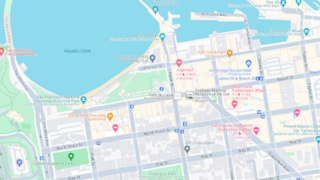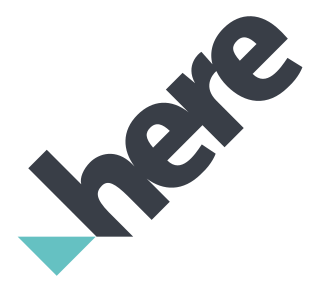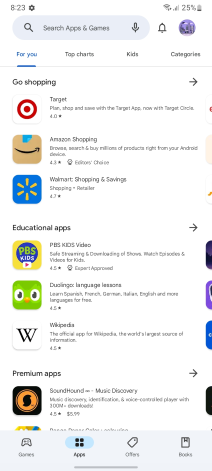
MSN is a web portal and related collection of Internet services and apps for Windows and mobile devices, provided by Microsoft and launched on August 24, 1995, alongside the release of Windows 95.

Google Maps is a web mapping platform and consumer application offered by Google. It offers satellite imagery, aerial photography, street maps, 360° interactive panoramic views of streets, real-time traffic conditions, and route planning for traveling by foot, car, bike, air and public transportation. As of 2020, Google Maps was being used by over one billion people every month around the world.

Google Pay Send, previously known as Google Wallet, was a peer-to-peer payments service developed by Google before its merger into Google Pay. It allowed people to send and receive money from a mobile device or desktop computer.

Bing for mobile is a search tool for handheld mobile devices from Microsoft as part of their Bing search engine. It is designed for mobile device displays. Bing Mobile is built into Windows Mobile and Windows Phone as proprietary software, accessed via the Search key on Windows Phone 7 and Windows Phone 8 devices. It is also available on Windows Phone 8.1, and can be downloaded for other platforms, including and Android.

Android is a mobile operating system based on a modified version of the Linux kernel and other open-source software, designed primarily for touchscreen mobile devices such as smartphones and tablets. Android is developed by a consortium of developers known as the Open Handset Alliance, though its most widely used version is primarily developed by Google. It was unveiled in November 2007, with the first commercial Android device, the HTC Dream, being launched in September 2008.

Here Technologies is an American–Dutch multinational group specialized in mapping technologies, location data and related automotive services to individuals and companies. It is majority-owned by a consortium of German automotive companies and American semiconductor company Intel whilst other companies also own minority stakes. Its roots date back to U.S.-based Navteq in 1985, which was acquired by Finland-based Nokia in 2007. Here is currently based in The Netherlands.

ChromeOS, sometimes styled as chromeOS and formerly styled as Chrome OS, is a Linux-based operating system developed and designed by Google. It is derived from the open-source ChromiumOS and uses the Google Chrome web browser as its principal user interface.

Google Play, also known as the Google Play Store and formerly Android Market, is a digital distribution service operated and developed by Google. It serves as the official app store for certified devices running on the Android operating system and its derivatives, as well as ChromeOS, allowing users to browse and download applications developed with the Android software development kit (SDK) and published through Google. Google Play has also served as a digital media store, offering games, music, books, movies, and television programs. Content that has been purchased on Google Play Movies & TV and Google Play Books can be accessed on a web browser and through the Android and iOS apps.
Microsoft mobile services are a set of proprietary mobile services created specifically for mobile devices, they are typically offered through mobile applications and mobile browser for Windows Phone, | platforms, BREW, and Java. Microsoft's mobile services are typically connected with a Microsoft account and often come preinstalled on Microsoft's own mobile operating systems while they are offered via various means for other platforms. Microsoft started to develop for mobile computing platforms with the launch of Windows CE in 1996 and later added Microsoft's Pocket Office suite to their Handheld PC line of PDAs in April 2000. From December 2014 to June 2015, Microsoft made a number of corporate acquisitions, buying several of the top applications listed in Google Play and the App Store including Acompli, Sunrise Calendar, Datazen, Wunderlist, Echo Notification Lockscreen, and MileIQ.
A digital newsstand is a digital distribution platform for downloadable newspapers, magazines and journals. Examples include Apple's Newsstand and Google Play Newsstand – both of which have been discontinued – Amazon Kindle Newsstand and Magzter. It is an online development of the traditional news stand.

AliOS is a Linux distribution developed by Alibaba Cloud, a subsidiary of Mainland Chinese company Alibaba Group. It is designed for smart cars and Internet of Things (IoT) devices, and it had been used as a mobile operating system.

Android KitKat is the codename for the eleventh Android mobile operating system, representing release version 4.4. Unveiled on September 3, 2013, KitKat focused primarily on optimizing the operating system for improved performance on entry-level devices with limited resources. The first phone with Android KitKat was the Nexus 5.

Google Play Newsstand was a news aggregator and digital newsstand service by Google. On May 8, 2018, Google announced at Google I/O that Google Play Newsstand was being amalgamated with Google News. Launched in November 2013 through the merger of Google Play Magazines and Google Currents, the service let users subscribe to magazines and topical news feeds, receiving new issues and updates automatically. Content was offered for reading on a dedicated Newsstand section of the Google Play website or through the mobile apps for Android and iOS. Offline download and reading is supported on the mobile apps.

Google Cardboard is a discontinued virtual reality (VR) platform developed by Google. Named for its fold-out cardboard viewer into which a smartphone is inserted, the platform was intended as a low-cost system to encourage interest and development in VR applications. Users can either build their own viewer from simple, low-cost components using specifications published by Google, or purchase a pre-manufactured one. To use the platform, users run Cardboard-compatible mobile apps on their phone, place it into the back of the viewer, and view content through the lenses.
The Nexus Player was a digital media player co-developed by Google, Intel and Asus. It was the second media player in the Google Nexus family of consumer devices. Originally running the Android 5.0 ("Lollipop") operating system, it was the first device to employ the Android TV platform. The Nexus player supports Google Cast, the feature for selecting and controlling media playback on a television that was first introduced by Chromecast. Sales of the Nexus Player were discontinued in May 2016, and product support ended in March 2018.

Here WeGo is a web mapping and navigation service, operated by HERE Technologies and originally developed by Nokia. In 2013, HERE Technologies released this web mapping application for Windows Phone and the World Wide Web as a revamped version of Nokia Maps. HERE Technologies released the HERE Maps application to the Android platform on December 10, 2014, and later for iOS on March 11, 2015. The company changed the product name to HERE WeGo in July 2016. It is the default maps service provider for the Amazon Fire tablets and smartphones.
LineageOS is an Android-based operating system for smartphones, tablet computers, and set-top boxes, with mostly free and open-source software. It is the successor to CyanogenMod, from which it was forked in December 2016, when Cyanogen Inc. announced it was discontinuing development and shut down the infrastructure behind the project. Since Cyanogen Inc. retained the rights to the Cyanogen name, the project rebranded its fork as LineageOS.

Puffin Browser is a remote browser developed by CloudMosa, an American mobile technology company founded by Shioupyn Shen.
/e/ is a fork of LineageOS, an Android-based mobile operating system, and associated online services. /e/ is presented as privacy software that does not contain proprietary Google apps or services, and challenges the public to "find any parts of the system or default applications that are still leaking data to Google."













